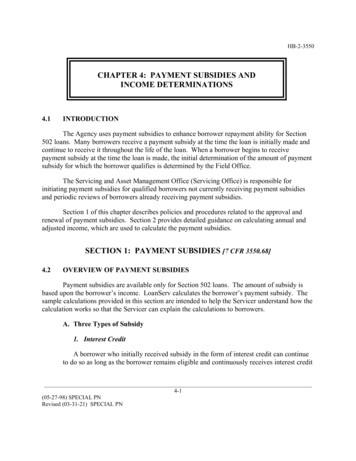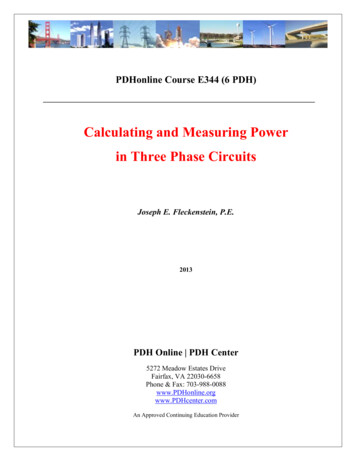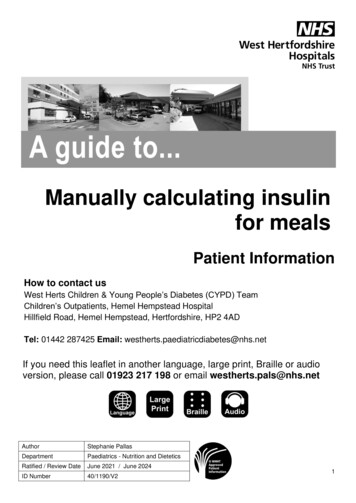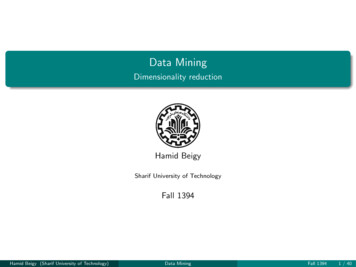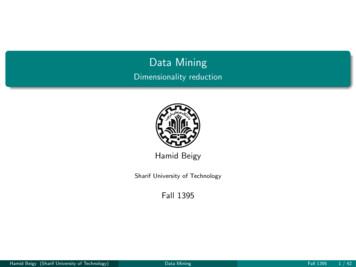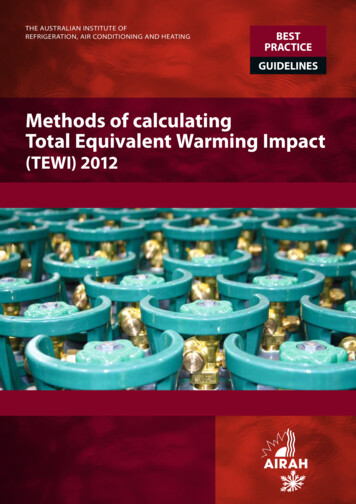
Transcription
THE AUSTRALIAN INSTITUTE OFREFRIGERATION, AIR CONDITIONING AND HEATINGBESTPRACTICEGUIDELINESMethods of calculatingTotal Equivalent Warming Impact(TEWI) 2012
METHODS OF CALCULATING TOTAL EQUIVALENT WARMING IMPACT (TEWI)BESTPRACTICEGUIDELINESBEST PRACTICE GUIDELINESMethods ofcalculatingTotal EquivalentWarming Impact(TEWI) 2012DisclaimerThe Australian Institute of Refrigeration, Air conditioning and Heating (AIRAH) would like to thank all those involved in developing the Best Practice Guideline:Methods of Calculating TEWI 2012, including the British Refrigeration Association for allowing AIRAH to use the 2006 standard as a base reference, projectsponsors Refrigerants Australia, AIRAH Natural Refrigerants special technical group, and the principal author, Expert Group. Special mention is made ofJonathan Fryer M.AIRAH, Kevin Lee M.AIRAH and Tony Queenin for their technical input. AIRAH 20122Design and layout: Artifishal Studios 140 Johnston St, Fitzroy Victoria 3065 Tel: 03 9417 7420 www.artifishal.com.auwww.airah.org.au
BEST PRACTICE GUIDELINESMETHODS OF CALCULATING TOTAL EQUIVALENT WARMING IMPACT (TEWI)Methods of calculating TotalEquivalent Warming Impact(TEWI) 2012BESTPRACTICEGUIDELINESContents1.Introduction 43.3.Total annual electricity consumption 111.1.Introduction 43.3.1.Compressor energy consumption 131.2.What is TEWI? 43.3.2. Ambient temperature BINSand operating hours 151.3.What is lCCP? 41.4.Relevance of TEWI 53.3.3. Energy consumptionof ancillary components 161.5.Limitations 53.3.4.Load factors for ancillary components 171.6.Existing systems 53.3.5.Heat rejection considerations 171.7.Calculation factors or parameters 53.3.6.Electricity consumption check 171.8.Revisions 63.4.Limitations 182.Method of calculation 7Appendices 202.1.Method of calculation Appendix A: Glossary 203. Calculation7parametersand factors 8Appendix B:Sample calculations 233.1.Direct emissions 8I) Self-contained retail display case 233.1.1.Leak rates 8II) Supermarket refrigeration system 259Appendix C: Resources 263.1.2. Global Warming Potential valuesfor refrigerants 3.1.3.Refrigerant recovery rates 103.2.Indirect emissions 113.2.1.Indirect emission factors I) Refrigerant leak rate references 26II) Useful references 27113www.airah.org.au
METHODS OF CALCULATING TOTAL EQUIVALENT WARMING IMPACT (TEWI)1Introduction1.1. IntroductionThis guide provides a standardised method of calculatingTotal Equivalent Warming Impact (TEWI) for new, stationaryrefrigeration and air conditioning systems at the designstage. Its aim is to assist facility operators, designers andindustry practitioners to compare the environmentalimplications of different technical options available to meettheir HVAC&R requirements.1.2. What is TEWI?TEWI is a measure of the global warming impact ofequipment based on the total related emissions ofgreenhouse gases during the operation of the equipmentand the disposal of the operating fluids at the end-of-life.TEWI takes into account both direct fugitive emissions,and indirect emissions produced through the energyconsumed in operating the equipment. TEWI is measuredin units of mass in kg of carbon dioxide equivalent (CO2-e).TEWI is calculated as the sum of two parts, they are:1. Refrigerant released during the lifetime of the equipment,including unrecovered losses on final disposal, and2. The impact of CO2 emissions from fossil fuels used togenerate energy to operate the equipment throughoutits lifetime.1.3. What is LCCP?LCCP TEWI GWP (indirect; energy consumption from chemicalproduction and transport, manufacturingcomponents/assembly and end-of-life)4BEST PRACTICE GUIDELINES G WP (direct; chemical refrigerant emissions incl.atmospheric reaction products, manufacturingleakage and end-of-life)LCCP differs from TEWI in that it specifically includes someitems excluded from TEWI. These are the direct fugitiveemissions during manufacture of equipment and fluids,and the greenhouse gas emissions associated with theirembodied energy. Pearson found that combined fugitiveemissions and embodied energy for the production ofR-134a and of R-404A accounted for around 1% of the GWPvalue, considerably less than the uncertainty in an LCCPcalculation for stationary equipment.The Air Conditioning, Heating and RefrigerationTechnology Institute (AHRTI) have developed astandardised methodology to calculate the LCCP ofstationary refrigeration and air conditioning equipment,contact AHRTI for details on their model.1.4. Relevance of TEWIThe need to control emissions of greenhouse gases as set outin the Kyoto Protocol requires ongoing careful considerationand evaluation of energy consuming activities. Manyactivities can result in the emission of more than one of thegreenhouse gases. TEWI is a methodology for computingthe total relevant emissions of greenhouse gases for specificapplications, in this case refrigeration and air conditioning.It is important to note that the largest impact of globalwarming from stationary refrigeration and air conditioningis through electricity generation to power the equipment.Approximately 45,000 GWh, or 21.9% of all electricity sent outin Australia in 2006 and resulted in as much as 7% (includingmobile air conditioning and refrigeration) of all greenhousegas emission in Australia in that year or 40 Mt of CO2-e.1.5. LimitationsTEWI calculations are dependent on a number ofassumptions about equipment performance and usepatterns, refrigerant properties, and electricity generationwww.airah.org.au
BEST PRACTICE GUIDELINESMETHODS OF CALCULATING TOTAL EQUIVALENT WARMING IMPACT (TEWI)efficiencies. The values used will be subject to considerableuncertainty. In particular, refrigerant GWP values aresubject to wide uncertainty levels (see section 3.1.2). It isimportant to appreciate therefore that small differences inTEWI may not be meaningful.Recommendations about sensitivity analysis (i.e. upper andlower threshold) and validity of comparisons are includedand it is important to bear these in mind if TEWI is to be auseful design tool. It must be emphasised that the TEWIcomparison, to be of real value, must relate to systems ofequal duty and function. There is little practical purposein comparing, for example, the TEWI values of a domesticrefrigerator and of a supermarket display cabinet.1.6. Existing systemsTEWI for an existing refrigeration system can be readilyderived from actual refrigerant usage data and measuredenergy consumed, normally over a full year. The purposeof this Guideline is to address the need to estimate TEWI atthe design stage, in order to assist proper decision-makingand investment in lower emission technology.1.7. Calculation factorsor parametersCalculation factors presented in this Guideline for variousindustry sectors represent current technology and industrybest practice for new stationary installations. The factorsare subject to change and will be updated as appropriate.It will therefore be important to use only factors from thelatest published version of the AIRAH guide and currentrefrigerant properties and indirect emission factors.The general method shown for calculating TEWI issimple and straightforward to use. Examples of simpleand complex vapour compression cycle refrigerationapplications are given in Appendix B for a self-containeddisplay case and a supermarket refrigeration system.Detailed models of these examples are provided inspreadsheet format to allow users to undertake furtheranalysis. The principles given here are readily extendedto other applications, including air conditioning, processrefrigeration and cold storage facilities, and the workbooktemplates provided can be adapted for these applications.1.8. RevisionsRecommendations for improvements or additions to thisdocument will be welcomed and should be addressed toAIRAH.5www.airah.org.au
METHODS OF CALCULATING TOTAL EQUIVALENT WARMING IMPACT (TEWI)BEST PRACTICE GUIDELINESMethod of calculation22.1. Method of calculationThis methodology for calculating total equivalent warming impact (TEWI) is for new stationary refrigerationand air conditioning (RAC) systems that operate on vapour compression principles and are powered by mainselectricity connected to the grid.The method of calculating TEWI is provided below:TEWI GWP (direct; refrigerant leaks incl. EOL) GWP (indirect; operation) (GWP x m x L annual x n) GWP x m x (1 – αrecovery)) (Eannual x β x n)Where:GWP Global Warming Potential of refrigerant, relative to CO2 (GWP CO2 1)Lannual Leakage rate p.a. (Units: kg)n System operating life (Units: years)m Refrigerant charge (Units: kg)αrecovery Recovery/recycling factor from 0 to 1Eannual Energy consumption per year (Units: kWh p.a.)β Indirect emission factor (Units: kg CO2 per kWh)The TEWI equation provided can be found, amongst other places, in EN 378-1: 2008, Refrigerating System and Heat PumpsSafety and Environmental Requirements, Annex B. When greenhouse gases may be emitted by insulation (i.e. display cases)or other components in the cooling or heating system the global warming potential of such gases is to be added to theabove equation.The aim of this method is to provide predictive estimates for the TEWI values of new systems that can be usefully comparedwith confidence, even when different estimators have prepared these. Sensitivity analysis is recommended to calculate lowerand upper threshold TEWI values, which provides an expected band.6www.airah.org.au
BEST PRACTICE GUIDELINES3METHODS OF CALCULATING TOTAL EQUIVALENT WARMING IMPACT (TEWI)Calculationparameters and factors3.1. Direct emissionsThere are four main types of direct emissions from HVAC&Requipment, they are: Gradual leaks during normal operation Catastrophic losses during normal operation Losses during plant service and maintenance Losses at end of plant life3.1.1. Leak ratesThe annual leak rate referred to in this Guideline is the sumof gradual leakage during normal operation, catastrophiclosses amortized over the life of the equipment and lossesduring service and maintenance expressed as a percentageof the initial charge per annum. Losses at the end of plantlife are not included in the annual leak rate.Annual leak rates vary significantly depending on the classof equipment, refrigerant type, vintage, equipment design(i.e. flared connections, Schrader valves, type of condenser),workmanship of installation, vibration elimination,refrigerant leak detection, maintenance and operatingconditions.This Guideline provides an upper, lower and typical annualleak rate for a variety of classes of HVAC&R equipment asa guide for practioners to undertake a TEWI calculationbased on a typical application or provide a range basedon an upper and lower threshold. The annual leak rates areprovided in Table 1 and Appendix C, i) Leak rate referencesprovides supporting references for these guidelines.www.airah.org.au3.1.2. Global WarmingPotential valuesfor refrigerantsThe Global Warming Potential of a refrigerant is definedas the integrated radiative forcing over a ‘time horizon’following an assumed release of 1kg divided by theintegrated radiative forcing over the same period fromrelease of 1 kg of carbon dioxide.The (Intergovernmental Panel on Climate Change) IPCChas refined GWP values over the past two decades,publishing four assessments, with a fifth assessmentunderway. The IPCC is recognized as the most authoritativescientific and technical voice on GWP values, and itsassessments are used in the United Nations FrameworkConvention (UNFCCC) and its Kyoto Protocol. The UNFCCCadopted the 100 year second assessment values (AR2),which are used as a basis for regulation in Australia andare the most widely used GWP values internationally.Whilst the fourth assessment values (AR4) are considereda more accurate technical appraisal, and it is possible thatthe AR4 values will be adopted by the UNFCCC in any postKyoto Protocol agreements, for the time being the AR2values are the ones being used as the basis for regulationand are the values recommended by this guideline.Table 2 provides a comparison of commonly usedrefrigerant gases and blends calculated based onthe second and fourth assessments.7
METHODS OF CALCULATING TOTAL EQUIVALENT WARMING IMPACT (TEWI)BEST PRACTICE GUIDELINESTable 1: Annual leak rates by equipment class/applicationAnnual leak rates (% p.a.)Equipment class/applicationLowerTypicalUpperCentralised system (i.e. supermarket rack)5%Maintained 12.5%,otherwise 15%23%Chillers (i.e. cold storage facilities, process refrigeration)5%7%16%Condensing units (i.e. Walk-in coolrooms)5%Maintained 12.5%,otherwise 15%23%Self-contained refrigeration system—2%—Road llers (HCFC-123)—2%—Roof top packaged systems4%5%9%Split systems (single and multi)3%4%9%Window/wall units and portable—2%—Refrigeration applicationsAir conditioning applicationsTable 2: GWP values forselected refrigerantsGWP values for selected refrigerantsAR2 1996AR4 2,138CO2HFC-32For comparison only, not covered by Kyoto Protocolor permitted for use in new equipment in Australia.8HCFC-221,5001,8103.1.3. Refrigerantrecovery ratesThe Intergovernmental Panel of Climate Change (IPCC)issue good practice guidelines of refrigerant recoveryefficiencies that range from 70% to 95% of remainingcharge depending on the equipment classes. In practicethe refrigerant recovery rate from a system with arefrigerant charge greater than 100 kg would be expectedto be 90 to 95% of the remaining charge, and around 70%for equipment with smaller charges. The losses at the endof plant life equate to less than 1% per annum amortizedover the life of the equipment.This Guideline recommends the use of a refrigerantrecovery rate of 70% of the original charge for systems witha refrigerant charge less than 100 kg and 95% for systemswith larger charges.3.2. Indirect emissionsIndirect electricity emission factors, sometimes referred toas CO2 emission factors, are based on average emissionsintensity of total electric sector generation for thecountry, State or region. The kg of CO2 emitted per kWhof electricity supplied is dependent on the fuel mix forelectricity generation. For coal fired power stations thefigure is relatively high, for gas-fired stations it is lower, andfor hydroelectric, wind power, or solar it is close to zero.www.airah.org.au
BEST PRACTICE GUIDELINESMETHODS OF CALCULATING TOTAL EQUIVALENT WARMING IMPACT (TEWI)3.2.1. Indirect emission factorsThere are many emission factors for practitioners tochoose from including marginal, current, projected,weighted average, scope 1, 2 or 3 factors and national,state or regional factors depending on the purpose.For consistency and simplicity the State based Scope 2factors published in the NGERS Technical Guidelines havebeen nominated as the preferred choice in this Guideline,which are listed in Table 3.The rated annual energy consumption of many selfcontained refrigeration units and air conditioningequipment can be found on www.energyrating.com.au. These ratings are required to comply with MinimumEnergy Performance Standards regulations or HighEfficiency Performances Standards and are based oncertified laboratory test conditions in accordance witha relevant test standard. This Guideline prescribes thatannual energy consumption ratings should be used whenavailable.State based scope 2 emission factors relate to theemissions that result from the generation of purchasedelectricity from each state‘s electricity grid and do notaccount for electricity lost in transmission and distribution.The NGERS factors are a based on a 3 year average thatis reviewed on an annual basis, which is anticipatedto decline over time due to efficiency improvementsin electricity generation and the emergence of morerenewable energy.When reliable annual energy consumption ratings are notavailable it must be calculated and the preferred methodis with an Annual Load Model that takes into account thefluctuations which would occur over a one year periodby calculating the compressor energy consumption fora range of ambient temperature segments (i.e. ambienttemperature BINS) for a nominated geographical location,which are discussed in more detail in the sections thatfollow.Table 3: Indirect (scope 2)emission factorsfor consumption ofpurchased electricity3.3.1. Compressor energyconsumptionThe energy consumed by the refrigeration compressor(s)depends on: Compressor run timeEmission factorkg CO2-e/kWh Cooling load required for the application New South Wales andAustralian Capital TerritoryCompressor efficiency – Co-efficientof performance (COP)0.89 Victoria1.21Temperature at which cooling is required(i.e. application, service or process temperatureof the space or produce being refrigerated)Queensland0.88 Temperature at which heat will be rejected– often this is the ambient temperatureSouth Australia0.68South West InterconnectedSystem in Western Australia0.80Tasmania0.30Northern Territory0.67State or TerritorySource: National Greenhouse and Energy Reporting SystemMeasurement, Technical Guidelines, Australian Government,Department of Climate Change and Energy Efficiency, July 2011.3.3. Total annual electricityconsumptionEach of the above variables can vary hour by hour andon a seasonal basis. It is therefore almost always necessaryto use an Annual Load Model to calculate compressorenergy consumption.The compressor input power is derived from compressormanufacturers’ data for each ambient temperature BIN,taking into account compressor cooling load, saturatedsuction temperature, suction gas super heat and designconditions including saturated condensing temperature,KTD (i.e. condenser operating temperature difference) andliquid sub-cooling temperature.1. Refrigeration compressor(s), andIn some cases, compressors may be cycling on and off,or cycling between capacity steps because the availablecapacity does not match exactly the compressor coolingload. In such cases the power figures should be factored tomake allowance for the percentage of run time in differentmodes with a load factor.2. Ancillary components essential to correct operation ofthe system as specified (i.e. condenser fans, evaporatorfans, defrost heaters, fluid circulation pumps, etc).Typically software supplied by compressor manufacturerswill be used by the designer to provide input power datafor each of the temperature BINS segments, which isThe total annual energy consumption of refrigeration or airconditioning system is the sum of the energy consumptionof the:www.airah.org.au9
METHODS OF CALCULATING TOTAL EQUIVALENT WARMING IMPACT (TEWI)multiply by the hours per year for each BIN to obtain thecompressor energy consumption (kWh) and totalled toprovide the annual power consumption. Table 4 providesan example of an Annual Load Model with 10 temperatureBINS for a medium temperature compressor operating onR134a in Melbourne.There are cases where the Annual Load Model can beconsiderably simplified with less temperature BINS (i.e.Low 15oC; Medium 15oC & 20oC and High 20oC).A domestic refrigerator, for example, operating inside acentrally conditioned house will have a nearly constantheat rejection temperature in addition to a nearly constantcooling load and service temperature would only require asingle rating point.The detailed methodology of preparing an Annual LoadModel for multiple compressor systems is best illustratedwith an example, which is provided in Appendix B ii) fora supermarket rack system. A spreadsheet model is alsoprovided, which allows selection options for the keyvariables.This example uses an average compressor load factor of80% as this is deemed to be the industry norm and thisis a comparative model. However, load factors can varysignificantly depending on the ambient conditions, systemdesign, compressor unloading and many other factors.Comparing the model versus actual values from a similarsystem provides good feedback on load factors.BEST PRACTICE GUIDELINES3.3.2. Ambient temperatureBINS and operating hoursThe operating hours of refrigeration and air conditioningequipment can vary depending on the ambient temperatureor climatic conditions. This Guideline provides typicaloperating hours for 10 ambient temperature BINS forlocations covering all capital cities and one or more locationfor each Building Code Board of Australia (BCA) climate zone.The operating hours are based on a five year average ofBureau of Meteorology weather station data. The locationsand climate zones provided in Table 5 and operating hoursfor each BIN segment our provided in Table 6.3.3.3. Energy consumptionof ancillary componentsThe annual energy consumption of the ancillarycomponents should include all components that arerequired to perform the required heating and coolingtasks. They include condenser and evaporator fan(s),defrost systems and cooling fluid circulation pumps, etc.Components that are not part of the system function(such as building lighting, etc) should not be included inthe energy consumption calculations. For the specific caseof refrigerated retail display cabinets, it is appropriate toinclude integral lighting in the calculations, but not thestore lighting.Table 4: Annual Load Model for 10 temperature BIN segmentsBIN #BINCompressorambientcoolingtemp (oC) load (kW)COPCompressorinput kWh p.a.)1 4043.2372.5816.781132 40 and 3545.5782.8516.02587433 35 and 3048.5043.1915.212032,4704 30 and 2551.9183.6114.405175,9565 25 and 2053.0793.7514.151,02611,6146 20 and 1553.0793.7514.152,3067 15 and 1053.0793.7514.152,83932,1378 10 and 553.0793.7514.151,64918,6679 5 and 053.0793.7514.151611,82310 irah.org.au
BEST PRACTICE GUIDELINESMETHODS OF CALCULATING TOTAL EQUIVALENT WARMING IMPACT (TEWI)Table 5: Locations and climate zonesBCA Climatezones1DescriptionHigh humid summer,warm winterLocationBOM Weather stationStation #LocationCairns31011Cairns AirportDarwin14015Darwin AirportTownsville32040Townsville Airport2Warm humid summer, mild winterBrisbane40913Brisbane3Hot dry summer, warm winterAlice Springs15590Alice Springs Airport4Hot dry summer, cool winterMildura76031Mildura AirportSydney66037Sydney AirportAdelaide23090Adelaide (Kent Town)Perth9021Perth AirportMelbourne86071Melbourne Regional OfficeHobart94008Hobart AirportCanberra70351Canberra AirportThredbo71032Thredbow5Warm temperate6Mild temperate7Cool temperate8Alpine3.3.4. Load factors forancillary components3.3.5. Heat rejectionconsiderationsWhen TEWI is being used in a competitive tenderingsituation, each of those tendering MUST use exactly thesame load factors for ancillary equipment for comparisonsof TEWI factors to be meaningful.The aim of the TEWI calculation methodology is toprovide predictive estimates so that new systemsperforming the same tasks can be usefully comparedwith confidence. In some instances different equipmentconfigurations such as external or internal heat rejectionmay impact on the refrigeration loads, equipmentoperating times and TEWI values.A recommended set of assumptions for this application, interms of running time, is as follows.Fixed speed fans90%AC VSD fans (1-phase)70%AC VSD fans (3-phase)60%DC EC fans50%Door heaters100%Cabinet integral lighting50%Defrost Heaters5%Crank case heaters have not been included as an ancillarycomponent as in commercial refrigeration applicationsthe energy consumption is negligible and for residentialand light commercial air conditioning applications it isalready included in the rated annual energy consumptioncalculations.If for any particular installation different assumptions areknown to be realistic, these may be used; however, the sameassumptions MUST be used for any comparative assessments.www.airah.org.auFor example, if a self-contained refrigeration displaycase that rejects heat into the conditioned space werecompared to a display case of equal duty and functionwith a remote condensing unit that rejects heat externally;an allowance for the heat rejection treatment would needto be included in the TEWI calculation. This allowance maytake into account the additional air conditioner operatingtime or energy required to remove the heat added by theself-contained equipment on hot days less the energysavings on cold days.3.3.6. Electricityconsumption checkIt is important to compare estimated electricityconsumption values versus actual electricity consumptionof a similar system. Electricity intensity check measures canbe useful tools to verify electricity consumption estimatesand assumptions.11
METHODS OF CALCULATING TOTAL EQUIVALENT WARMING IMPACT (TEWI)BEST PRACTICE GUIDELINESTable 6: Operating hours by location for 10 temperature BIN segmentsBIN #BINambienttemp ( C)AdelaideBrisbaneCairnsCanberraDarwinHobart1 400000002 40 and 358303271023 35 and 30268345862001958634 30 and 257151590336350547011705 25 and 20160736373811111817717496 20 and 1526902259795210229921697 15 and 10255590519121732132858 10 and 5716308111763018809 5 and 0125270716044010 0100156028,7608,7608,7608,7608,7608,760TotalBIN #BINambienttemp ( C)MelbournePerthSydneyTownville1 401311002 40 and 3558989203 35 and 302033223065044 30 and 2551772679638815 25 and 2010261676201427976 20 and 1523062946239411467 15 and 102839222420303598 10 and 51649701916739 5 and 016136202010 000008,7608,7608,7608,760TotalFor comparisons to be useful it is important to compare‘like for like’ and make adjustments to take into account anydifferences (i.e. ambient conditions, refrigeration load, etc.).The most common differences that effect benchmarks areclimate and operating hours.Table 7 provides electricity consumption check measuresfor the following common stationary refrigeration and airconditioning applications: 12 Supermarket refrigeration application(small, medium and large or algorithm)Cold storage facilities (small, mediumand large or algorithm)Walk-in coolroom (kWh per m2)Commercial air conditioning (kWh per m2)Note the electricity consumption check measures arenot intended to be a design guide for energy efficiencyor refrigeration intensity, they are to be used as checkmeasures to verify the ‘order of magnitude’ of calculatedelectricity consumption (i.e. 20%). An example isprovided in Appendix B ii) for a supermarket rack system.3.4. LimitationsIn practical terms it is very difficult to calculate ameaningful ABSOLUTE value for TEWI. Its great value,when applied to refrigeration and air conditioningsystems, is as a COMPARATIVE TOOL for evaluatingdifferent system approaches to satisfy a given refrigerationapplication need.www.airah.org.au
BEST PRACTICE GUIDELINESMETHODS OF CALCULATING TOTAL EQUIVALENT WARMING IMPACT (TEWI)IPCC (Intergovernmental Panel on Climate Change) reportsa 35% margin of uncertainty for early assessments ofGWP values. This uncertainty is a combination of variousuncertainties, including that of the true atmosphericlifetime for CO2. The comparative uncertainties of thevalues for fluorocarbons are around 10%.Energy demand equivalent for manufacturing andtransporting refrigerant and refrigeration equipment hasbeen EXCLUDED from TEWI calculations. Although it ispossible to calculate the impact of these in TEWI terms, thevalues have been shown to be insignificant. Allocation ofCO2 emissions arising from component manufacture is madewhen using life cycle climate performance (LCCP) calculationsand these are discussed further in Appendix C ii).This means that if two refrigeration systems using differentrefrigerants are compared, and their calculated TEWIvalues are within 10% of each other, then essentially theirEnvironmental Warming Impacts are the same.TEWI may be used for comparisons of alternative proposalsfor retrofitting existing systems. In this case, as the systemsexist, many of the operational parameters will be knownand the calculation will be based on these. However, it islikely to be virtually impossible to estimate leakage rates ofdifferent refrigerants from an existing system. Considerablecare will therefore be essential in establishing this particularsectoral loss factor in such instances.Table 7: Electricity consumption check measures by applicationApplicationSupermarketUnit ofmeasureElectricityintensity (kWhper m2 p.a.) fortrading floorCategory/sizeCheck measurekWh/m2Small 1500 m2980Medium 1500 and 2750 m2850Large 2750 m2820Specific electricity consumption (SEC)2Cold storage facilitySEC (kWh/m3 p.a.) ((38.978 x (storage volume/0.0283)-0.2275) – 0.1581)/0.0283Refer look up tables in Appendix Bii) for formulae in Excel format.Walk in coolroomsAnnual electricity consumption (kWh p.a.) can be estimated based on total inputwatts of the condensing unit and evaporator operating 16 hours per day, 365 daysper annum. Refrigeration intensity check value for coolrooms with heights of 3 to 4mis 250 to 300 kWr per m2.Commercialair conditioningAnnual electricity consumption (kWh p.a.) can be estimated based on total inputs wattsof the condensing unit and evaporator operating 1,255 per annum (i.e. 251 business days,10 hours per day, 50% operating at full load). Cooling load check value for commercialair conditioning is 200 kWr per m2 of conditioned space.13www.airah.org.au
METHODS OF CALCULATING TOTAL EQUIVALENT WARMING IMPACT (TEWI)Appendix ABEST PRACTICE GUIDELINESGlossaryAlternative refrigerantsCondensing temperatureAlternative to synthetic refrigerants used in stationaryrefrigeration and air conditioning equipment. The mostcommonly used alternative refrigerants are Anhydrousammonia (R717), Carbon Dioxide (R744) and hydrocarbons(R290). These refrigerants are typically referred to as naturalrefrigerants.Condensing temperature, also referred to as the boilingpoint or saturation temperature is the temperature atwhich a re
Design and layout: Artifishal Studios 140 Johnston St, Fitzroy Victoria 3065 Tel: 03 9417 7420 www.artifishal.com.au Methods of calculating Total Equivalent Warming Impact (TEWI) 2012 BEST PRACTICE . or other components in the cooling or heating system the global warming potential of such gases is to be added to the

